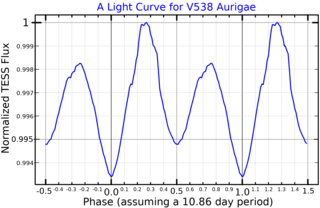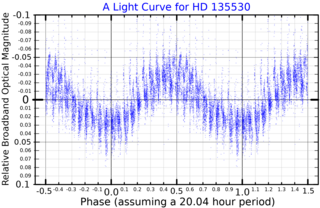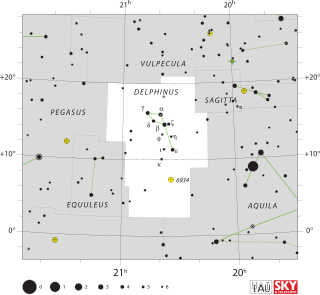Related Research Articles
Lambda1 Tucanae is the Bayer designation for one member of a pair of stars sharing a common proper motion through space, which lie within the southern constellation of Tucana. As of 2013, the pair had an angular separation of 20.0 arc seconds along a position angle of 82°. Together, they are barely visible to the naked eye with a combined apparent visual magnitude of 6.21. Based upon an annual parallax shift for both stars of approximately 16.5 mas as seen from Earth, this system is located roughly 198 light years from the Sun.

9 Aurigae is a star system in Auriga (constellation). It has an apparent magnitude of about 5, making it visible to the naked eye in many suburban skies. Parallax estimates made by the Hipparcos spacecraft put it at about 86 light-years from the solar system, although individual Gaia Data Release 3 parallaxes place all three components at 88 light years.
6 Aurigae is a star in the constellation Auriga. Its apparent magnitude is 6.48.

31 Camelopardalis is a binary star system in the northern circumpolar constellation of Camelopardalis. It is visible to the naked eye as a dim point of light with a peak apparent visual magnitude of +5.12. Parallax measurements provide a distance estimate of approximately 460 light years away from the Sun, and the system is drifting closer to the Earth with a radial velocity of −3 km/s.
HR 3220 is a binary star system in the southern constellation of Carina. It has the Bayer designation B Carinae; HR 3220 is the designation from the Bright Star Catalogue. It has a yellow-white hue and is visible to the naked eye with an apparent visual magnitude of 4.75. Based upon parallax measurements, it is located at a distance of 59 light years from the Sun. The system is drifting further away with a radial velocity of +24 km/s.
HD 125072 is a star in the southern constellation of Centaurus. It is a challenge to view with the naked eye, having an apparent visual magnitude of 6.637. The star is located at a distance of 38.6 light years from the Sun based on parallax. It is drifting closer with a radial velocity of −14.9 km/s. The components of the space velocity for this star are U=−18.5, V=−6.9 and W=−26.9 km/s.
HD 221776 is a double star in the northern constellation of Andromeda. With an apparent visual magnitude of 6.18, it is viewable by the naked eye user very favourable conditions. The most luminous component has a spectral classification K5III, meaning that it is an orange giant star that has evolved off the main sequence. An infrared excess has been detected around this star, indicating the star is associated with a cloud of dust particles.
HD 88809 is a star located in the southern constellation Antlia. With an apparent magnitude of 5.89 it is barely visible to the naked eye under ideal conditions. The star is located at a distance of around 451 light years but is drifting away at a heliocentric radial velocity of almost 20 km/s.
HD 36678 is single star in the northern constellation of Auriga. This star is dimly visible to the naked eye with an apparent visual magnitude of 5.83. It is located at a distance of approximately 840 light years from the Sun based on parallax.

V538 Aurigae is a single star in the northern constellation of Auriga. With an apparent visual magnitude of 6.23, this star requires good dark sky conditions to view with the naked eye. It is located at a distance of 40.0 light-years (12.3 pc) from Sun based on parallax. The star is drifting further away with a radial velocity of 0.9 km/s. It is a member of the Local Association, and is most likely a thin disk star.

HD 135530 is a suspected variable star in the northern constellation of Boötes.
4 Camelopardalis is a probable multiple star in the northern constellation of Camelopardalis, located 177 light years away from the Sun, based upon parallax. With a combined apparent visual magnitude of 5.29, it is visible to the naked eye as a faint, white-hued star. The pair have a relatively high proper motion, traversing the celestial sphere at an angular rate of 0.158″ per year. The system's proper motion makes it a candidate for membership in the IC 2391 supercluster. They are moving away from the Earth with a heliocentric radial velocity of 22.5 km/s.

Zeta1 Antliae is the Bayer designation for a binary star system in the southern constellation of Antlia. Based upon parallax measurements, the pair are located at a distance of roughly 350 light-years from Earth. They have apparent magnitudes of +6.20 and +7.01 and are separated by 8.042 arcseconds. The apparent magnitude of the combined system is +5.76, which is bright enough to be seen with the naked eye in suitably dark skies.
ο Ophiuchi, Latinized as Omicron Ophiuchi, is a wide double star in the equatorial constellation of Ophiuchus. The co-moving pair are visible to the naked eye as a dim point of light, with the two components having apparent visual magnitudes of 5.14 and 6.59. As of 2015, they had an angular separation of 10.0″ along a position angle of 354°. The distance to both stars is approximately 281 light years based on parallax, and they are drifting closer to the Sun with a radial velocity of around −29 km/s.

Omega1 Cygni, Latinized from ω1 Cygni, is the Bayer designation for a solitary star in the northern constellation of Cygnus. It is visible to the naked eye with an apparent visual magnitude of 4.94. Based upon an annual parallax shift of 2.59 mas, it is estimated to lie roughly 1,260 light years from the Sun. Relative to its neighbors, this star has a peculiar velocity of 25.7±2.2 km/s.
39 Draconis is a wide binary star system in the northern circumpolar constellation of Draco. It has the Bayer designation b Draconis, while 39 Draconis is the Flamsteed designation. This system is visible to the naked eye as a dim, white-hued point of light with an apparent visual magnitude of 5.0. Parallax measurements made by the Hipparcos spacecraft put it at a distance of 184 light-years, or 56 parsecs away from the Sun. The system is moving closer to the Earth with a heliocentric radial velocity of -24.5 km/s.
90 Tauri is a star in the zodiac constellation of Taurus, located 144 light-years away from the Sun. It is visible to the naked eye as a faint, white-hued star with an apparent visual magnitude of 4.27. 90 Tauri is a member of the Hyades cluster and is listed as a double star.

κ Delphini is a binary star system in the constellation Delphinus. It is faintly visible to the naked eye, with an apparent magnitude of 5.05. It is located about 98.8 light-years away, based on its parallax.
η Microscopii, Latinised as Eta Microscopii, is a solitary star in the constellation Microscopium. It is visible to the naked eye as a dim, orange-hued star with an apparent visual magnitude of 5.53. The star is located around 910 light-years distant from the Sun based on parallax, and is drifting further away with a radial velocity of +22 km/s.
HD 46815 is a solitary star in the southern constellation Columba. It is faintly visible to the naked eye with an apparent magnitude of 5.4 and is estimated to be 408 light years away. However, it is receding with a heliocentric radial velocity of 32.2 km/s.
References
- 1 2 Brown, A. G. A.; et al. (Gaia collaboration) (August 2018). "Gaia Data Release 2: Summary of the contents and survey properties". Astronomy & Astrophysics . 616. A1. arXiv: 1804.09365 . Bibcode: 2018A&A...616A...1G . doi: 10.1051/0004-6361/201833051 . Gaia DR2 record for this source at VizieR.
- 1 2 3 4 5 6 Høg, E.; Fabricius, C.; Makarov, V. V.; Urban, S.; Corbin, T.; Wycoff, G.; Bastian, U.; Schwekendiek, P.; Wicenec, A. (2000), "The Tycho-2 catalogue of the 2.5 million brightest stars", Astronomy & Astrophysics, 355: L27–L30, Bibcode:2000A&A...355L..27H.
- 1 2 Brown, A. G. A.; et al. (Gaia collaboration) (August 2018). "Gaia Data Release 2: Summary of the contents and survey properties". Astronomy & Astrophysics . 616. A1. arXiv: 1804.09365 . Bibcode: 2018A&A...616A...1G . doi: 10.1051/0004-6361/201833051 . Gaia DR2 record for this source at VizieR.
- 1 2 3 4 5 Brown, A. G. A.; et al. (Gaia collaboration) (August 2018). "Gaia Data Release 2: Summary of the contents and survey properties". Astronomy & Astrophysics . 616. A1. arXiv: 1804.09365 . Bibcode: 2018A&A...616A...1G . doi: 10.1051/0004-6361/201833051 . Gaia DR2 record for this source at VizieR.
- 1 2 3 4 5 6 Houdebine, E. R. (2010). "Observation and modelling of main-sequence star chromospheres - XIV. Rotation of dM1 stars". Monthly Notices of the Royal Astronomical Society. 407 (3): 1657–1673. Bibcode:2010MNRAS.407.1657H. doi: 10.1111/j.1365-2966.2010.16827.x .
- 1 2 Tamazian, Vakhtang S.; Docobo, José A.; Melikian, Norair D.; Karapetian, Arthur A. (2006). "MK Classification and Dynamical Masses for Late-Type Visual Binaries". Publications of the Astronomical Society of the Pacific. 118 (844): 814. Bibcode:2006PASP..118..814T. doi: 10.1086/504881 .
- 1 2 Mermilliod, J.-C. (1986). "Compilation of Eggen's UBV data, transformed to UBV (unpublished)". Catalogue of Eggen's UBV Data. Bibcode:1986EgUBV........0M.
- 1 2 Nidever, David L.; Marcy, Geoffrey W.; Butler, R. Paul; Fischer, Debra A.; Vogt, Steven S. (2002). "Radial Velocities for 889 Late-Type Stars". The Astrophysical Journal Supplement Series. 141 (2): 503–522. arXiv: astro-ph/0112477 . Bibcode:2002ApJS..141..503N. doi:10.1086/340570. S2CID 51814894.
- 1 2 3 van Leeuwen, F. (2007). "Validation of the new Hipparcos reduction". Astronomy and Astrophysics. 474 (2): 653–664. arXiv: 0708.1752 . Bibcode:2007A&A...474..653V. doi:10.1051/0004-6361:20078357. S2CID 18759600. Vizier catalog entry
- 1 2 3 4 Kiyaeva, O. V. (2001). "An astrometric study of the triple star ADS 48". Astronomy Letters. 21 (6): 391–397. Bibcode:2001AstL...27..391K. doi:10.1134/1.1374678. S2CID 121012446.
- ↑ Díez Alonso, E.; et al. (January 2019). "CARMENES input catalogue of M dwarfs". Astronomy and Astrophysics. 621 A126. arXiv: 1810.03338 . Bibcode: 2019A&A...621A.126D . doi: 10.1051/0004-6361/201833316 . Vizier catalog entry
- ↑ "GSC 03246-01561". SIMBAD . Centre de données astronomiques de Strasbourg . Retrieved 13 July 2013.
- ↑ "GSC 03246-00320". SIMBAD . Centre de données astronomiques de Strasbourg . Retrieved 13 July 2013.
- ↑ Cvetković, Z.; et al. (2012). "System ADS 48: Visual Binary or Multiple System". The Astronomical Journal. 144 (3) 80. Bibcode: 2012AJ....144...80C . doi: 10.1088/0004-6256/144/3/80 . S2CID 120045704.